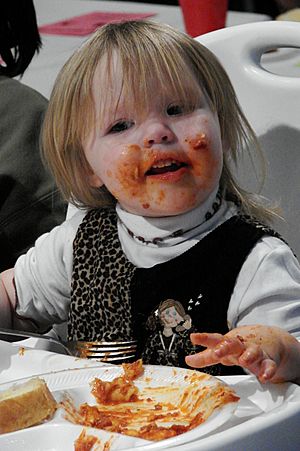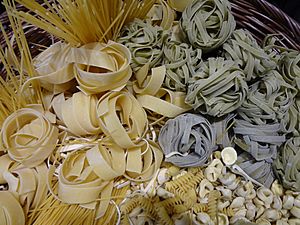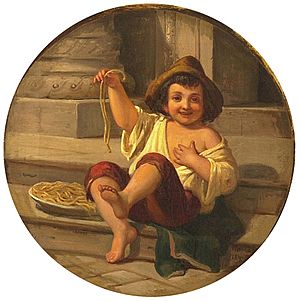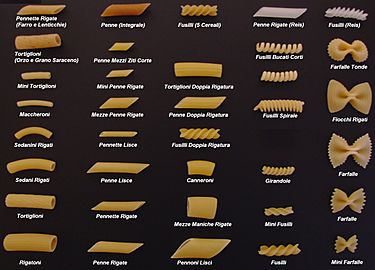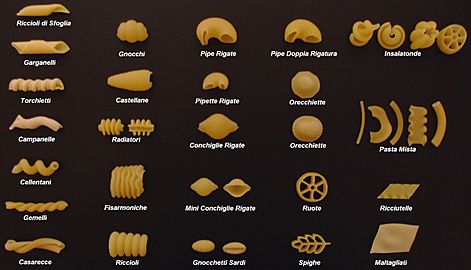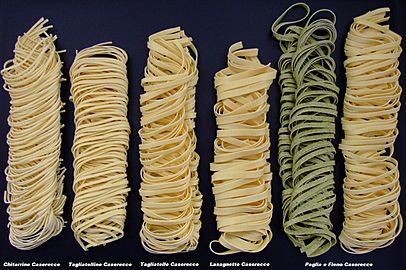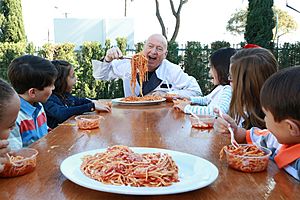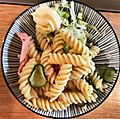Pasta facts for kids
|
A child eating pasta
|
|
| Type | Staple ingredient for many dishes |
|---|---|
| Place of origin | Italy |
| Main ingredients | Durum wheat flour |
| Ingredients generally used | Water, eggs |
| Variations | Rice flour pasta, Legume pasta |
Pasta is a very popular staple food from Italian cuisine. It's usually made from a dough of durum wheat flour mixed with water or eggs. This dough is then shaped into sheets or many different forms. After shaping, pasta is cooked by boiling or baking.
Sometimes, other flours like rice flour or flour from legumes (like beans or lentils) are used. This can give pasta a different taste and texture. It also makes gluten-free options for those who can't eat wheat.
Pasta comes in two main types: dried and fresh. Most dried pasta is made in factories using a process called extrusion. Fresh pasta is often made by hand, sometimes with simple machines. Large machines are used to make fresh pasta sold in stores.
There are hundreds of different pasta shapes! In Italy, the names for pasta shapes can change from one town to another. For example, cavatelli pasta has 28 different names depending on where you are. Common pasta shapes include long strands, short pieces, tubes, flat sheets, and tiny shapes for soup. Some pasta is even made to be filled or stuffed.
Pasta dishes are usually simple to make. Some are served as a small first course or for light lunches, like pasta salads. Other dishes are larger and can be a full dinner. Pasta sauces also come in many tastes, colors, and textures.
From a nutrition point of view, cooked plain pasta is mostly carbohydrates (starch). It has some protein and is low in fat. It also contains a bit of manganese. Pasta can also be made with whole grains or have extra vitamins and minerals added.
Contents
What's in a Name: The Word "Pasta"
The word "pasta" first appeared in English in 1874. It comes from the Italian word pasta. This word, in turn, came from the Latin word pasta. The Latin word was a form of the Greek word pāstá, which meant "barley porridge".
A Look Back: The History of Pasta
Ancient writings from the 1st century AD mention lagana. These were thin sheets of fried dough eaten every day. A cookbook from the early 5th century describes a dish called lagana with layers of dough and meat. This was an early version of modern-day lasagna. However, these old dough sheets were not cooked like today's fresh or dry pasta.
The first clear information about pasta products in Italy comes from the 13th or 14th century.
Historians have found other old mentions of pasta-like foods. For example, the Greek doctor Galen (2nd century AD) wrote about itrion. This was a mix of flour and water. The Jerusalem Talmud says that itrium, a boiled dough, was common in Palestine from the 3rd to 5th centuries AD.
An Arab doctor and writer from the 9th century, Isho bar Ali, described itriyya. This was a string-like food made from semolina and dried before cooking. In 1154, the geographer Muhammad al-Idrisi wrote about itriyya being made and sent out from Sicily. He said:
West of Termini there is a delightful settlement called Trabia. Its ever-flowing streams propel a number of mills. Here there are huge buildings in the countryside where they make vast quantities of itriyya which is exported everywhere: to Calabria, to Muslim and Christian countries. Very many shiploads are sent.
One type of itriyya with a long history is laganum. This Latin word for a thin sheet of dough led to the Italian word lasagna.
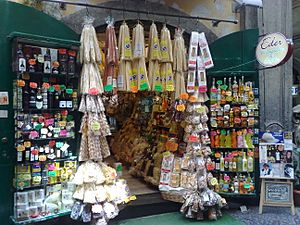
In North Africa, a food similar to pasta called couscous has been eaten for centuries. However, couscous is more like small droplets of dough, not the stretchy dough of pasta. At first, dry pasta was a luxury in Italy. This was because it took a lot of work to knead the durum wheat semolina.
There's a common myth that Marco Polo brought pasta from China. This story actually started with a magazine called the Macaroni Journal. It was published by food companies to help sell pasta in the United States. The truth is pasta first appeared in Italy a significant time before Marco Polo began his travels to Asia. Although it is unclear how pasta reached the European continent, some historians suggest that Arabs brought pasta to Sicily in the 9th century.
In Greek mythology, it's believed that the god Hephaestus invented a machine to make strings of dough. This might be the earliest idea of a pasta maker!
In the 14th and 15th centuries, dried pasta became very popular. It was easy to store, which was great for long journeys. This allowed people to take pasta on ships when they explored the New World. A century later, pasta was found all over the world thanks to these voyages.
Tomatoes arrived in Italy in the 16th century. They became part of Italian cooking in the 17th century. But the first written recipes for pasta with tomato sauce appeared much later, in the late 18th century. Before tomato sauce, people ate pasta dry with their fingers. The liquid sauce made using a fork necessary!
How Pasta Was Made Over Time
In the early 17th century, Naples had simple machines to make pasta. Later, kneading machines and presses were invented. These made pasta manufacturing much cheaper. In 1740, the first pasta factory was given a license in Venice.
During the 1800s, water mills and stone grinders helped separate semolina from the bran. This helped the pasta market grow. In 1859, Joseph Topits started the first pasta factory in Hungary. It used steam machines and was one of the first in Central Europe. By 1867, the Buitoni Company in Sansepolcro, Tuscany, was a well-known pasta maker.
In the early 1900s, new ways of drying and extrusion (pushing dough through shaped holes) allowed for more types of pasta. It also meant much larger amounts could be made for export. This time was called "The Industry of Pasta."
How Pasta Has Changed
Using tomato sauce with pasta was a big change. Before, pasta was often eaten plain. How people eat pasta has also changed. It used to be a small, simple dish. Now, it's often eaten in larger portions and as part of fancy meals. Pasta's low price and easy cooking have helped it become so popular.
Pasta Today
The art of making pasta has grown a lot since it first started. It's thought that Italians eat over 60 pounds (27 kg) of pasta per person each year! This is much more than Americans, who eat about 20 pounds (9 kg) per person. Pasta is so loved in Italy that they often have to import wheat to make enough pasta for everyone. Today, pasta is everywhere. You can find many types in local supermarkets. Most pasta is now made in large factories, with only a small amount still made by hand.
Pasta used to be only part of Italian and European food. But as it became popular worldwide, pasta crossed borders. It's now a popular fast food and a staple in North America and other places. This happened because many Italians moved to Canada and the United States in the early 1900s. Similarly, many Italians moved to South Africa, making spaghetti with meatballs a key part of their food culture.
What Pasta is Made Of

For a long time, basic pasta dough has been made mostly from wheat flour or semolina. Durum wheat is used a lot in Southern Italy, while softer wheat is common in the North. In some areas, other grains like barley, buckwheat, rye, rice, and corn have been used. Even chestnut and chickpea flours are sometimes used.
For people who can't eat gluten (like those with coeliac disease or wheat allergy), some pasta recipes use rice or maize flour. Cooked potatoes can also be added to grain flours.
Other things can be added to the flour and liquid mix. These include vegetable purees like spinach or tomato, mushrooms, cheeses, herbs, and spices. Most pasta is made from dough that doesn't use yeast. However, some types of pasta are made with yeast-raised dough.
Vitamins and minerals are often added to dried, store-bought pasta. These nutrients are lost from the wheat during milling. So, they are added back to the semolina flour. These can include niacin (vitamin B3), riboflavin (vitamin B2), folate, thiamine (vitamin B1), and iron.
Different Kinds of Pasta
Fresh Pasta
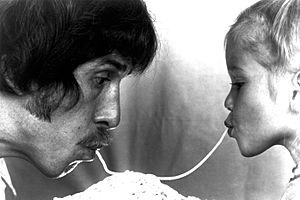
Fresh pasta is usually made locally with fresh ingredients. If it's going to be shipped, makers consider how quickly ingredients like eggs or herbs might spoil. Fresh pasta is often made with eggs and all-purpose flour or "00" low-gluten flour. Because it has eggs, it's softer than dried pasta and cooks in about half the time. Light sauces are best for fresh pasta so the pasta's flavor can shine.
Fresh pasta doesn't get much bigger after cooking. So, you need about 1.5 pounds (0.7 kg) of fresh pasta to serve four people generously. Fresh egg pasta is usually cut into strands of different widths and thicknesses. Examples include fettuccine, pappardelle, and lasagne. It's also great for making filled pastas like ravioli, tortellini, and cannelloni.
Fresh egg pasta is very popular in the Piedmont and Emilia Romagna regions of North Italy. Here, the dough is made only from egg yolk and flour. This gives it a very fine taste and texture. This pasta is often served simply with butter sauce and thin slices of truffles, which grow in that region. In other areas, like Apulia, fresh pasta can be made without eggs. The dough only needs semolina flour and water. This is often shaped into orecchiette or cavatelli. Fresh pasta for cavatelli is also popular in places like Sicily. But there, the dough is made differently, using flour and ricotta cheese.
Dried Pasta
Dried pasta is also called factory-made pasta. It's usually made in large amounts using big machines. Dried pasta is mainly shipped to faraway places and lasts longer on the shelf. The ingredients for dried pasta are semolina flour and water. Eggs can be added for flavor, but they are not needed.
Unlike fresh pasta, dried pasta needs to be dried at a low temperature for several days. This removes all the moisture, allowing it to be stored for a long time. Dried pastas are best with hearty dishes like ragu sauces, soups, and casseroles. Once cooked, dried pasta usually doubles in size. So, about 1 pound (0.45 kg) of dried pasta can serve up to four people.
How Pasta is Used in Cooking
Pasta is usually served with some kind of sauce. The sauce and pasta type are often chosen to match each other, making it easy to eat. In Northern Italian cooking, less tomato sauce, garlic, and herbs are used. White sauce is more common. However, Italian food is best known by its individual regions.
Pasta dishes with less tomato are found in Trentino-Alto Adige and Emilia Romagna. In Bologna, the meat-based Bolognese sauce uses a small amount of tomato paste. A green sauce called pesto comes from Genoa. In Central Italy, you'll find sauces like tomato sauce, amatriciana, arrabbiata, and the egg-based carbonara.
Tomato sauces are also found in Southern Italian cooking, where they first appeared. In Southern Italy, more complex dishes include pasta with fresh vegetables, olives, capers, or seafood. Examples are puttanesca, pasta alla norma (tomatoes, eggplant, and fresh or baked cheese), pasta con le sarde (fresh sardines, pine nuts, fennel, and olive oil), and spaghetti aglio, olio e peperoncino (with garlic, olive oil, and hot chili peppers).
How Pasta is Made
Making Fresh Pasta
To make pasta dough, you need semolina flour, egg, salt, and water. First, the flour is piled on a flat surface, and a hole is made in the middle. The egg is poured into this hole, and a fork is used to mix the egg and flour. There are many ways to shape the pasta sheets depending on the type you want. Popular types include penne, spaghetti, and macaroni.
Kitchen pasta machines, also called pasta makers, are popular for people who make a lot of fresh pasta. You feed sheets of dough into the machine by hand. By turning a hand crank, the machine rolls the pasta to make it thinner step by step. For the last pass, the pasta can go through a special "comb" to cut the noodles into shapes as they come out.
Factory-Made Pasta
The ingredients for dried pasta usually include water and semolina flour. Eggs might be added for color and richness in some types. Vegetable juice (like spinach, beet, tomato, carrot), herbs, or spices can also be added for color and flavor.
After mixing semolina flour with warm water, the dough is kneaded by machines until it becomes firm and dry. If the pasta is to be flavored, eggs, vegetable juices, and herbs are added at this point. The dough then goes into a laminator to be flattened into sheets. Next, a vacuum mixer-machine presses the dough to remove air bubbles and extra water. The moisture content is reduced to 12%. Then, the dough is put in a steamer to kill any bacteria.
The dough is then ready to be shaped. Depending on the type of pasta, the dough can be cut or pushed through special shapes called dies. The pasta is then dried in a special tank. The heat, moisture, and time depend on the pasta type. Finally, the dried pasta is packaged. Fresh pasta is sealed in clear, airtight plastic containers with a mix of carbon dioxide and nitrogen. This stops germs from growing and makes the pasta last longer. Dried pastas are sealed in clear plastic or cardboard packages.
Gluten-Free Pasta
Gluten is a protein found in grains like wheat, rye, and barley. It helps give regular pasta its firm texture when cooked. Gluten-free pasta is made using other flours instead of wheat flour. These can include vegetable powders, rice, corn, quinoa, amaranth, oats, and buckwheat flours. Other things might be added to gluten-free pasta to make it cook better or feel more like wheat pasta.
Storing Pasta
How you store pasta depends on how it was made and how dry it is. Uncooked, dry pasta can stay in a cupboard for a year if it's in an airtight container in a cool, dry place. Cooked pasta should be kept in the refrigerator for up to five days in an airtight container. Adding a little oil can help keep it from sticking together. Cooked pasta can also be frozen for two or three months. If pasta is completely dried, it can be put back in the cupboard.
Images for kids
-
A small hand-cranked pasta machine designed to sheet fresh pasta dough and cut tagliatelle.
See also
 In Spanish: Pasta para niños
In Spanish: Pasta para niños


